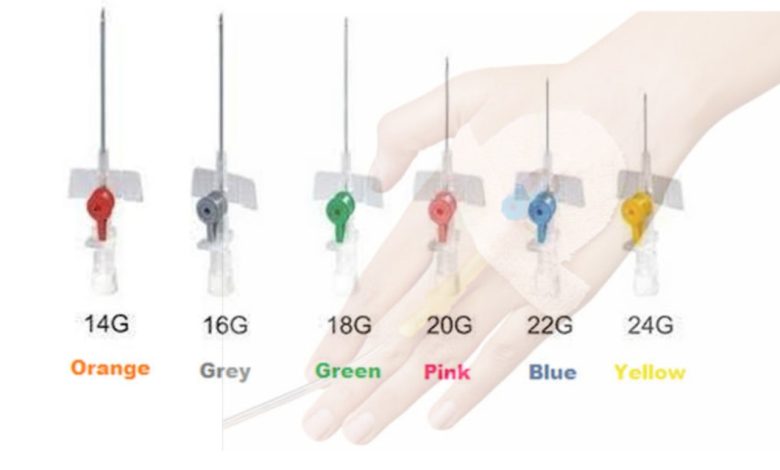6 Types of Cannula Sizes and Colors

A cannula is a thin tube that is inserted into a vein, artery, or body cavity to deliver or withdraw fluid or gases. The word “cannula” comes from the Latin word “canna,” which means “reed.” The use of cannulas dates back to ancient times. In the second century A.D., the Greek physician Galen described using a reed to insert fluids into the body. In the Middle Ages, metal cannulas were used for bloodletting, a common medical practice at the time.
The modern cannula was developed in the early 20th century by Dr. Ralph Waters, a professor of anesthesia at the University of Wisconsin. Dr. Waters was looking for a way to administer anesthesia more safely and effectively, and he developed a thin metal tube that could be inserted into a patient’s vein to deliver the anesthetic directly into the bloodstream.
During World War II, plastic cannulas were developed and used by military medics to treat wounded soldiers. These cannulas were lighter and more flexible than the metal cannulas previously used, making them easier to transport and use in the field.
Today, cannulas are used in a variety of medical procedures, including the delivery of intravenous medications and fluids, the removal of excess fluid from the body, and the delivery of oxygen to patients who are having difficulty breathing. There are many different types of cannulas available, each designed for a specific use and application.
Types of Cannula Size and Colors
Cannulas come in different sizes and colors, each designed for a specific use and application. The size of the cannula is determined by the diameter of the tube, measured in gauge, with smaller gauge numbers indicating larger diameters. In the United States, the most common sizes and colors for peripheral cannulas are:
14-gauge (orange): This is used for trauma or surgery patients who require a rapid infusion of large volumes of fluids or blood products. 14-gauge cannulas are the largest size available and are typically only used in emergency situations or for patients who require a rapid infusion of large volumes of fluids or blood products. They have a diameter of 1.98 mm.
16-gauge (gray): This is used for patients who require a rapid infusion of moderate volumes of fluids or blood products. 16-gauge cannulas are slightly smaller than 14-gauge cannulas and are also used for rapid infusion of fluids or blood products. They have a diameter of 1.65 mm.
18-gauge (green): This is used for most patients who require IV therapy, including medication administration and fluid replacement. 18-gauge cannulas are the most common size used for peripheral IV therapy. They have a diameter of 1.27 mm and are suitable for most patients who require IV therapy.
20-gauge (pink or yellow): This is used for patients who require IV therapy, but have small or fragile veins. 20-gauge cannulas are smaller than 18-gauge cannulas and are often used for patients with small or fragile veins, such as pediatric patients or elderly patients. They have a diameter of 0.89 mm.
22-gauge (blue): This is used for patients who require IV therapy, but have very small or fragile veins. 22-gauge cannulas are even smaller than 20-gauge cannulas and are used for patients with very small or fragile veins. They have a diameter of 0.71 mm.
24-gauge (yellow): This is used for pediatric patients, neonates, or other patients with very small veins. 24-gauge cannulas are the smallest size available and are used for neonates or other patients with extremely small veins. They have a diameter of 0.56 mm.
The length of the cannula may also vary, depending on the intended use and the patient’s anatomy. Peripheral cannulas can range in length from 0.75 inches to 1.5 inches, while central venous catheters (CVCs) can be several inches long and are inserted into larger veins near the heart.
In addition to the gauge size, cannulas are color-coded to help healthcare providers select the appropriate size. However, the color-coding system may vary between healthcare facilities or countries. It is important for healthcare providers to double-check the size and gauge of the cannula before use to ensure patient safety.
How long should a cannula stay in?
The length of time that a cannula can stay in place depends on several factors, including the type of cannula, the patient’s condition, and the purpose of the cannula.
In general, peripheral cannulas (cannulas inserted into veins in the arms or legs) can remain in place for up to 72 to 96 hours, depending on the hospital or healthcare facility’s policies. However, if the cannula becomes dislodged, the site becomes red or swollen, or the patient develops a fever or signs of infection, it may need to be removed earlier.
For central venous catheters (CVCs), which are inserted into larger veins near the heart, the length of time they can remain in place is usually longer, ranging from several days to several weeks or even months, depending on the type of catheter and the patient’s condition. However, CVCs are generally monitored more closely and require more frequent dressing changes and other maintenance procedures to minimize the risk of infection.
It’s important to note that the length of time a cannula can stay in place varies depending on the patient’s condition and response to therapy, so healthcare providers will need to evaluate the patient’s individual situation and determine the appropriate duration for the cannula. They will also monitor the cannula site regularly for signs of complications, such as infection, phlebitis, or infiltration. If any problems occur, the cannula may need to be removed earlier than planned.
Benefits Of Cannulas
Cannulas have a number of benefits, including:
1. Improved patient comfort: Cannulas are generally more comfortable for patients than traditional needles. This is because they are smaller in diameter and cause less trauma to the surrounding tissue when they are inserted. This is especially important for patients who require prolonged IV therapy, such as cancer patients or those with chronic illnesses, who may experience discomfort and pain with repeated needle insertions.
2. Reduced risk of needlestick injuries: Cannulas are designed to remain in place for extended periods, reducing the need for frequent needle insertions. This can help to decrease the risk of needlestick injuries to healthcare providers, who are at risk of exposure to bloodborne pathogens such as HIV, hepatitis B, and hepatitis C.
3. More efficient medication delivery: Cannulas allow for continuous infusion of medications or fluids, which can help to maintain a steady blood concentration and provide more consistent therapeutic effects. This can be particularly important for medications with a narrow therapeutic window, such as chemotherapy drugs or antibiotics.
4. Greater accuracy in medication dosing: Cannulas are typically calibrated to ensure accurate medication dosing. This can help to reduce the risk of over- or under-dosing, which can lead to adverse events or treatment failure. For example, in neonatal and pediatric patients, precise medication dosing is critical to prevent medication errors and ensure the best possible outcomes.
5. Reduced risk of infiltration: Cannulas are designed to be inserted into veins, reducing the risk of infiltration (when the medication or fluid leaks into the surrounding tissue) that can occur with traditional needles. Infiltration can cause tissue damage and delay the delivery of medications or fluids, which can lead to adverse events or treatment failure.
6. Improved mobility: Cannulas can be secured to the patient’s arm or hand with tape or an adhesive dressing, allowing the patient greater mobility and flexibility during IV therapy. This can be particularly important for patients who are ambulatory or who need to move around during their hospital stay.
7. Reduced risk of infection: Cannulas are typically made of sterile materials and are inserted using an aseptic technique, reducing the risk of infection compared to traditional needles. Infection is a serious risk associated with IV therapy and can lead to complications such as sepsis. Cannulas can help to reduce the risk of infection by minimizing the number of needle insertions and by ensuring that the IV site is properly cleaned and maintained.
Overall, the benefits of cannulas are numerous and can help to improve patient outcomes, reduce healthcare costs, and improve the safety of IV therapy. However, it is important to use them correctly and to carefully monitor patients to ensure that they are receiving the intended therapeutic effects and are not experiencing any adverse reactions.
Safety Protocol Associated With Using Cannula
There are several safety protocols associated with using a cannula, which healthcare providers must follow to minimize the risk of complications and ensure the safety of the patient. Some of these protocols include:
1. Hand hygiene: Healthcare providers must perform hand hygiene before and after handling the cannula to prevent the spread of infection.
2. Sterile technique: Cannulas should be inserted using a sterile technique, which involves using sterile gloves, masks, and other equipment to prevent contamination.
3. Site selection: Healthcare providers must carefully select the site for cannula insertion, taking into account factors such as the size and condition of the vein, the patient’s medical history, and any contraindications to venous access.
4. Proper insertion: Cannulas should be inserted at the correct angle and depth to minimize the risk of complications such as infiltration, phlebitis, or nerve injury.
5. Monitoring: Healthcare providers should monitor the cannula site regularly for signs of complications, such as redness, swelling, pain, or discharge.
6. Dressing changes: Cannula dressings should be changed regularly, according to the healthcare facility’s policies, to prevent contamination and infection.
7. Removal: Cannulas should be removed promptly when no longer needed, or if signs of complications develop, such as infection or infiltration.
8. Patient education: Healthcare providers should educate patients on the importance of proper cannula care, including keeping the site clean and dry, avoiding pulling on the cannula, and reporting any signs of complications promptly.
By following these safety protocols, healthcare providers can minimize the risk of complications associated with cannula use and ensure the safety and well-being of their patients.





